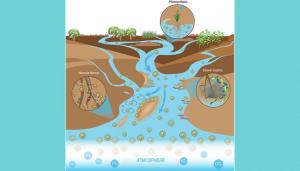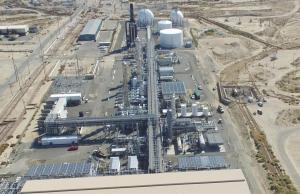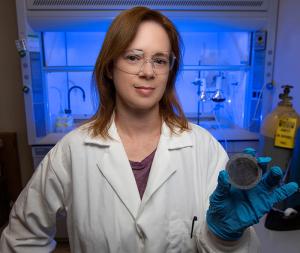LAB REPORT
Science and Technology Making Headlines
Nov. 6, 2020


A conceptual analogy for PROMISE, which proposes that carbon cycling in soils is analogous to the movement of water in a river delta system. Image by Janelle Cataldo/LLNL.
They can go their own way
Like water molecules in a river, soil carbon atoms are always in motion.
To better understand this action, Lawrence Livermore scientists and collaborators have created a new conceptual framework as well as a simulation model that traces the path of individual carbon atoms as they interact with the environment — undergoing biochemical transformations, moving through the soil pore space and progressing toward their final fate — carbon dioxide (CO2).
Soils store more carbon than the atmosphere and biosphere combined and the balance between soil organic carbon (SOC) formation and loss will drive powerful carbon climate feedbacks over the coming century.
The most common approach to predict SOC dynamics use pool-based models, which assume classes of SOC with internally homogeneous physical and chemical properties. But new evidence shows that soil carbon turnover is not dominantly controlled by the chemistry of carbon inputs, but by how it moves through its spatially and temporally heterogeneous environment.
The new framework, called Probabilistic Representation of Organic Matter Interactions Within the Soil Environment (PROMISE), uses process-based, probabilistic approaches focused on carbon flow and dynamic transformations, "fluxes" as opposed to discrete pools.


Under a proposal heading for an environmental review in 2021, carbon dioxide would be removed from the emissions stream of the Elk Hills Power Plant. Photo courtesy of California Resources Corp.
A step toward carbon neutral in Kern County
Momentum is building in the push to make Kern County nationally competitive in carbon management, the emerging field of trying to slow climate change by removing or reducing greenhouse gases.
Because of carbon management's environmental promise, it's possible Sacramento's goal of making California "carbon neutral" by 2045 may yet be of some benefit to Kern.
A report released in January by Lawrence Livermore National Laboratory concluded the state can achieve that goal by burying or offsetting 125 megatons per year of carbon dioxide. It also pointed to a significant role for Kern.
In addition to outlining land management practices and waste material processing, Livermore recognized local oil formations' vast geologic capacity for permanently storing carbon dioxide.


LLNL chemist Dawn Shaughnessy and her team helped discover five elements on the periodic table.
She got us at alchemy
Creating a new element is a lot like alchemy; you're taking one element and turning it into a completely different element.
And for LLNL’s Dawn Shaughnessy, “that was just the coolest stuff I’d ever heard, and I realized that's what I really wanted to do."
An element is the smallest piece of matter that still retains the properties of that matter. The elements are organized into the periodic table. Shaughnessy and her team helped add five new, never-before existing elements, to this famous table.


Using a custom volumetric additive manufacturing 3D printer, Lawrence Livermore researchers were able to build tough and strong, as well as stretchable and flexible, objects nearly instantly from a class of materials known as thiol-ene resins. Photo by Maxim Shusteff/LLNL.
3D printing is one class act
A new class of materials adapted by researchers at Lawrence Livermore enable nearly instant production through volumetric 3D printing and expanding the range of material properties achievable with the technique.
The materials are called thiol-ene resins, and they can be used with LLNL’s volumetric additive manufacturing (VAM) techniques, including computed axial lithography (CAL), which produces objects by projecting beams of 3D patterned light into a vial of resin. As light cures the liquid resin into a solid at the desired points in the volume, the vial spins. The resin is drained, leaving the 3D object behind. The whole process takes place in a matter of seconds.
The researchers worked previously with acrylate-based resins that produce brittle objects using the CAL process. The new resin, created through the careful balancing of three different types of molecules, is more versatile, giving the researchers a flexible design space and a wider range of mechanical performance. The researchers were able to build tough and strong materials, as well as stretchable and flexible objects using a custom VAM printer at LLNL.


Job review site Glassdoor is out with a new report that ighlights the 20 highest rated companies for work-life balance in the age of COVID-19.
A great place to work even during a pandemic
Striking a good work-life balance has long been a priority for many U.S. workers, but the COVID-19 pandemic has changed that from a priority to a near necessity. Job review site Glassdoor is out with a new report that highlights the 20 highest rated companies for work-life balance in the age of the novel coronavirus.
According to Glassdoor data, employee reviews mentioning mental health-related topics rose by 42 percent in July 2020 compared to six months earlier. The report also reveals that employers at the top 20 companies are making it a priority to ensure that their employees are meeting work priorities while also allowing for much-needed breaks.
Lawrence Livermore came in at No. 11 and was the only government agency listed in the Top 20. Among benefits, employees said flexible schedules and telecommuting are pluses.





